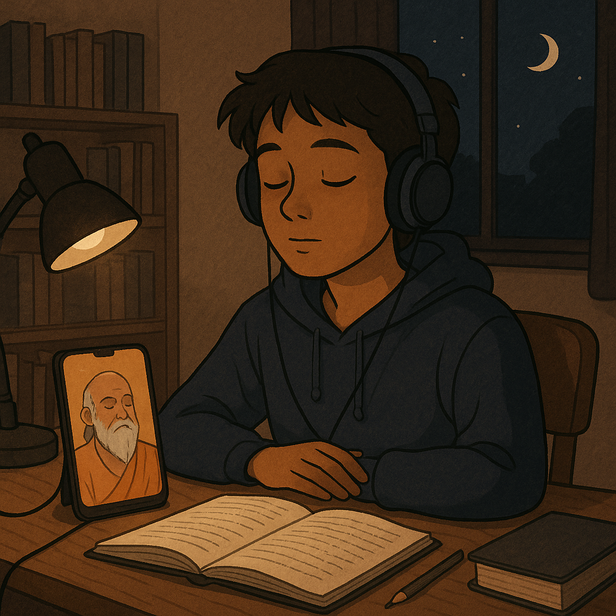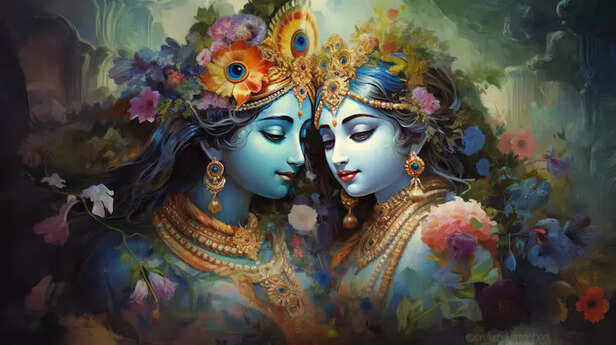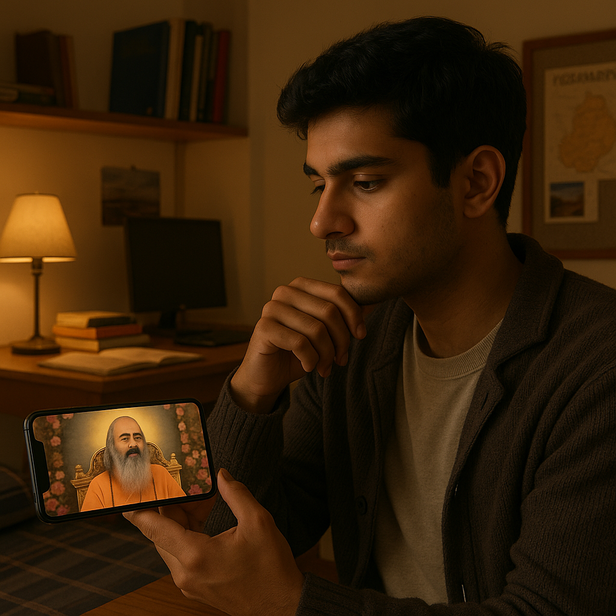The Bhakti comeback: How Premanand Ji Maharaj is inspiring Gen-Z
Charu Sharma | Times Life Bureau | Jul 10, 2025, 22:40 IST
( Image credit : Times Life Bureau, Timeslife )
As Gen Z battles anxiety, loneliness, and digital burnout, many are turning to the soulful path of bhakti for peace and purpose. Premanand Ji Maharaj’s emotionally powerful kathas and devotion to Radha Rani are resonating deeply with young hearts. His simple message of love, surrender, and naam jaap is inspiring a quiet spiritual revolution-one message, one ekantik vartalap, and one healed heart at a time.
Gen-Z is the most emotionally spent generation in history, but they are also the most connected. Gen Z is looking inward after growing up in a digital world, surrounded by hustle culture, and navigating a sea of options. All things spiritual are becoming more popular, including yoga, tarot, therapy, and manifestation. However, Bhakti-pure, emotional devotion, is quietly gaining traction without the use of hashtags or trends. And the one voice that has a strong hold on this generation? Premanand Ji Maharaj. Maharaj Ji, who is well-known for his affection for Radha Rani, his gentle storytelling, and his capacity to transform timeless spiritual principles into vibrant realities, is not only a saint but also a spiritual mentor for today's young people. This is not just a comeback of bhakti , it’s a comeback of the soul.

When it comes to mental health, Gen Z is not shy. However, even after self-help practices, journaling, and therapy, many people continue to ask: Why do I feel disconnected? This is where the surprisingly grounding practice of Bhakti, or devotional spirituality, comes in handy. Emotional release, not religion. In his Ekantik vartalap sessions , Premanand Ji Maharaj frequently discusses letting go, loving without ego, and re-establishing a connection with something greater than oneself. His slow, almost meditative style is the ideal counterpoint to a generation that is always distracted by speed. After hearing just one of his talks, many young listeners say they feel emotionally lighter. They sensed a change, not because they "understood" everything. There is a calmness in his pauses, chants, and steady recitation of Radha's name that is absent from contemporary life. His kathas are often full of silence-not empty pauses, but calm ones. The kind where young listeners, seated in crowded halls or hostels, suddenly feel the weight in their chest soften.

Radha Rani is central to Premanand Ji Maharaj's teachings, not as a far-off god but rather as a representation of grace, emotional fortitude, and pure love. In his kathas, Radha is living the kind of selfless love that many young people long for but are unable to find in contemporary relationships—rather than merely waiting for Krishna. The fear of vulnerability, validation-chasing, and ghosting have all been witnessed enough by today's generation. Radha, on the other hand, stands for a love that isn't demanding, domineering, or comparable. It's refreshing. Her story serves as a mirror, demonstrating that emotional depth is not a sign of weakness, particularly for young women. It is lucidity. Her dignity in love speaks to people of all sexes and faiths, especially when it is told through stories rather than sermons. Because of Premanand Ji's delicate narration, Radha's persona comes across as approachable and real rather than legendary. In his every sentence is : "Radhe Radhe"

Gen Z lives online, let's face it. Surprisingly, though, Bhakti content is quietly becoming very popular. These days, YouTube shorts and Instagram reels all feature brief extractions from Premanand Ji Maharaj's talks, frequently lasting less than 60 seconds. They aren't for sale. They're not clickbait. They are merely unadulterated, soulful narrative fragments. They are powerful because of this. Thousands of saves and comments like "This made me cry" are made several reels featuring Maharaj Ji saying, "Naam jap karo, man shaant ho jaayega" , "Ye dikhte hain , lekin koi hai nahi apna" , "Sansar me sab sambhandh jhoothe hain" The idea that Bhakti is only for the elderly has changed as a result of this digital spread, and it is now seen as a healing force for all. Particularly in small, manageable doses that frequently show up just when needed. A lot of young viewers find these clips by chance and stick around for the silence.

A strange but beautiful shift is happening. Across cities and campuses, young people are planning satsangs instead of Saturday night parties. They’re hosting bhajan circles, attending Maharaj Ji’s live kathas, and even involving themselves with more and more "naam jap".This isn’t forced; it’s a choice. Maharaj Ji’s energy makes it feel safe.When he speaks, you don’t feel judged. You feel welcomed. There’s no spiritual hierarchy , no one is holier than you. There’s only love, and plenty of it.Many students and working professionals share stories like these:“I started listening to Maharaj Ji after a panic attack during exams.”“I watched one clip during my breakup and ended up in tears, but they were tears of relief.”“His words guided me towards the right path". Under Premanand Ji’s light, bhakti is no longer outdated. It’s intimate.

One of the most common themes in Premanand Ji Maharaj’s talks is the simple but powerful practice of “Naam Jap”-the repetition of the divine name, usually Radhe Radhe . It’s not a chant linked to rituals; it’s a calming rhythm for the soul.Maharaj Ji often says, “Naam jap se sab theek ho jata hai". At first glance, it may seem too simple for a generation used to complex tools and methods to improve their mental state. But that’s exactly why it works.Unlike meditation apps, mood trackers, or social advice, Naam Jap doesn’t need any explanation or expertise. You don’t need to sit in perfect posture or understand every word. You simply have to call out : with intent, with softness, with surrender.For Gen Z-facing racing thoughts, comparison culture, and the pressure to always “find themselves”-this repetitive, focused practice offers a way to manage emotions without overthinking. It serves as a spiritual reset button, quieting the noise both outside and within.According to Maharaj Ji, Naam Jap isn't about escaping reality. It’s about grounding yourself in something eternal when everything around you keeps shifting.
So in conclusion : Premanand Ji Maharaj may not be a viral influencer or a mainstream face—but his presence is growing in youth spaces. Not because he’s trying to reach them, but because his message is emotionally genuine. In a time when Gen Z is seeking clarity, connection, and calm, his quiet call to Bhakti feels more like a mirror than a lecture . It doesn’t push. It invites.
This isn’t about tradition reclaiming the youth-it’s about the youth reclaiming themselves. He speaks - of love, of Radha, of freedom. And somehow, a generation known for rebellion is sitting down, listening, and letting go. They’re letting go of false love. Of fear. Of chaos. And they’re replacing it with chants, tears, and spiritual softness.
FAQs (Frequently Asked Questions) :
Emotional exhaustion driving Gen-Z towards Bhakti

a student listening to satsang
( Image credit : Times Life Bureau )
When it comes to mental health, Gen Z is not shy. However, even after self-help practices, journaling, and therapy, many people continue to ask: Why do I feel disconnected? This is where the surprisingly grounding practice of Bhakti, or devotional spirituality, comes in handy. Emotional release, not religion. In his Ekantik vartalap sessions , Premanand Ji Maharaj frequently discusses letting go, loving without ego, and re-establishing a connection with something greater than oneself. His slow, almost meditative style is the ideal counterpoint to a generation that is always distracted by speed. After hearing just one of his talks, many young listeners say they feel emotionally lighter. They sensed a change, not because they "understood" everything. There is a calmness in his pauses, chants, and steady recitation of Radha's name that is absent from contemporary life. His kathas are often full of silence-not empty pauses, but calm ones. The kind where young listeners, seated in crowded halls or hostels, suddenly feel the weight in their chest soften.
He made Radha Rani known among the youth again

radha krishna image
( Image credit : Freepik )
Radha Rani is central to Premanand Ji Maharaj's teachings, not as a far-off god but rather as a representation of grace, emotional fortitude, and pure love. In his kathas, Radha is living the kind of selfless love that many young people long for but are unable to find in contemporary relationships—rather than merely waiting for Krishna. The fear of vulnerability, validation-chasing, and ghosting have all been witnessed enough by today's generation. Radha, on the other hand, stands for a love that isn't demanding, domineering, or comparable. It's refreshing. Her story serves as a mirror, demonstrating that emotional depth is not a sign of weakness, particularly for young women. It is lucidity. Her dignity in love speaks to people of all sexes and faiths, especially when it is told through stories rather than sermons. Because of Premanand Ji's delicate narration, Radha's persona comes across as approachable and real rather than legendary. In his every sentence is : "Radhe Radhe"
His Kathas Are Viral - But Never Vain

youth watching spiritual content
( Image credit : Times Life Bureau )
Gen Z lives online, let's face it. Surprisingly, though, Bhakti content is quietly becoming very popular. These days, YouTube shorts and Instagram reels all feature brief extractions from Premanand Ji Maharaj's talks, frequently lasting less than 60 seconds. They aren't for sale. They're not clickbait. They are merely unadulterated, soulful narrative fragments. They are powerful because of this. Thousands of saves and comments like "This made me cry" are made several reels featuring Maharaj Ji saying, "Naam jap karo, man shaant ho jaayega" , "Ye dikhte hain , lekin koi hai nahi apna" , "Sansar me sab sambhandh jhoothe hain" The idea that Bhakti is only for the elderly has changed as a result of this digital spread, and it is now seen as a healing force for all. Particularly in small, manageable doses that frequently show up just when needed. A lot of young viewers find these clips by chance and stick around for the silence.
From loud parties to soft prayers - he’s reshaping youth culture

Man offering prayer
( Image credit : Freepik )
A strange but beautiful shift is happening. Across cities and campuses, young people are planning satsangs instead of Saturday night parties. They’re hosting bhajan circles, attending Maharaj Ji’s live kathas, and even involving themselves with more and more "naam jap".This isn’t forced; it’s a choice. Maharaj Ji’s energy makes it feel safe.When he speaks, you don’t feel judged. You feel welcomed. There’s no spiritual hierarchy , no one is holier than you. There’s only love, and plenty of it.Many students and working professionals share stories like these:“I started listening to Maharaj Ji after a panic attack during exams.”“I watched one clip during my breakup and ended up in tears, but they were tears of relief.”“His words guided me towards the right path". Under Premanand Ji’s light, bhakti is no longer outdated. It’s intimate.
“Naam Jap” as the ultimate anchor in an unsteady world

woman doing mala jaap
( Image credit : Freepik )
One of the most common themes in Premanand Ji Maharaj’s talks is the simple but powerful practice of “Naam Jap”-the repetition of the divine name, usually Radhe Radhe . It’s not a chant linked to rituals; it’s a calming rhythm for the soul.Maharaj Ji often says, “Naam jap se sab theek ho jata hai". At first glance, it may seem too simple for a generation used to complex tools and methods to improve their mental state. But that’s exactly why it works.Unlike meditation apps, mood trackers, or social advice, Naam Jap doesn’t need any explanation or expertise. You don’t need to sit in perfect posture or understand every word. You simply have to call out : with intent, with softness, with surrender.For Gen Z-facing racing thoughts, comparison culture, and the pressure to always “find themselves”-this repetitive, focused practice offers a way to manage emotions without overthinking. It serves as a spiritual reset button, quieting the noise both outside and within.According to Maharaj Ji, Naam Jap isn't about escaping reality. It’s about grounding yourself in something eternal when everything around you keeps shifting.
So in conclusion : Premanand Ji Maharaj may not be a viral influencer or a mainstream face—but his presence is growing in youth spaces. Not because he’s trying to reach them, but because his message is emotionally genuine. In a time when Gen Z is seeking clarity, connection, and calm, his quiet call to Bhakti feels more like a mirror than a lecture . It doesn’t push. It invites.
This isn’t about tradition reclaiming the youth-it’s about the youth reclaiming themselves. He speaks - of love, of Radha, of freedom. And somehow, a generation known for rebellion is sitting down, listening, and letting go. They’re letting go of false love. Of fear. Of chaos. And they’re replacing it with chants, tears, and spiritual softness.
FAQs (Frequently Asked Questions) :
- Is Naam Jap linked to any specific religion or can anyone practice it?Naam Jap is universal and emotion-driven , it welcomes all, regardless of faith.
- Are there live satsangs by Premanand Ji Maharaj that youth can attend?Yes , there are live satsangs aswell as daily ekantik vartalaps which are streamed online for easy access.
- Can Bhakti help with anxiety and overthinking in young people?Many youth say Bhakti practices like chanting bring them emotional clarity and calm.
